 |
|
“The One And Only…
meets The Man With No Name”
Sean Connery's return as
007 was announced on March 2, 1971, and shooting on Diamonds Are Forever
began the following month. Prior to the release of the seventh film in
the series there were re-issues
of three of Sean Connery's earlier James Bond films that had been out of
circulation for over a year. The advertising campaign utilised the tag-line “The One And Only...”
- as if to erase the existence of George Lazenby from the public's memory
forever. Although made in 1964, A Fistful of Dollars, the first of
Sergio
Leone’s so-called ‘spaghetti westerns’, was not screened in London until May 1967,
when it received less than rave reviews and a limited release. After
its success in the US and that of its sequel For A Few Dollars More (1965)
[not released in London until October 1967],
United Artists decided to re-release the two together on a double-bill at
the London Pavilion in April
1969, and
later also paired them with two James Bond films. Although advertised as a
double-bill and a Quad-crown poster printed, separate Double-crown posters
were also available for each film. Cinemagoers had to be over 18
years of age
to see the complete programme as the Clint Eastwood films were given an ‘X’ certificate when
first classified by the British Board of Film Censors. Prior to July
1, 1970, cinemagoers had to be aged 16 or over in order to be admitted to an
‘X’ certificate film. A new category ‘AA’ was introduced on the same day
restricting entry to those films for anyone under 14 years of age. This
classification was abolished in 1982 when the BBFC overhauled all of its
ratings in the wake of the videotape home entertainment boom,
and was replaced by the more easily understood ‘15’ certificate. |
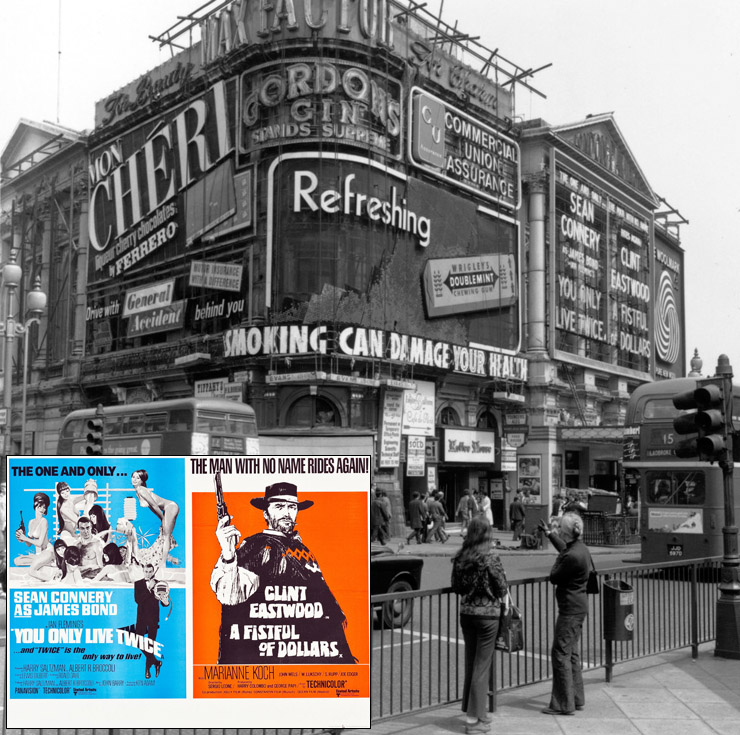 |
|
You Only Live
Twice went out with A Fistful of Dollars and played for three
weeks at the London Pavilion from Thursday May 6, 1971 (playing
simultaneously at the New Victoria and ODEON Kensington for the first week); whilst Goldfinger was paired with For A Few Dollars More
and screened at the London Pavilion for three weeks from Thursday June 24,
1971 (also playing for one week at the New Victoria from Thursday July 8,
1971), before a general release across UK from mid-August until the end of the year. |
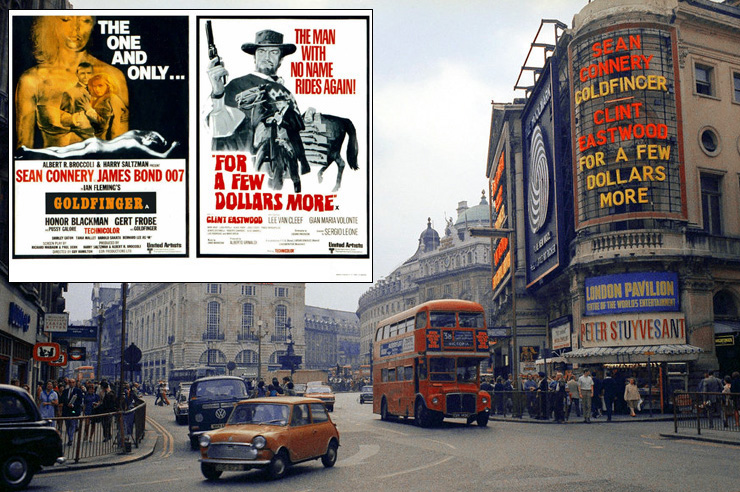 |
|
Some provincial
cinemas chose to play the double-bills in the evenings only, pairing the
Bond film in afternoon performances with either The Magnificent Seven
(1960), or its sequel Return of the Seven (1966) - both of
which were classified with an ‘A’ certificate, thereby allowing children
under 16 to attend unaccompanied by an adult. A third double-bill of
From Russia With Love and Hang ‘Em High (a 1968 western also
starring Clint Eastwood) played for one week from Thursday December 2,
1971 at the New Victoria cinema opposite Victoria Station, although had
been playing provincially since November 7th, and continued to screen across
the country until the general release of Diamonds Are Forever on
February 27, 1972. |
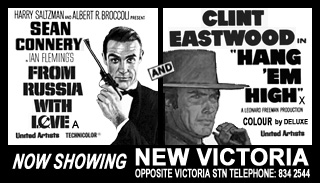 |
|
|
United Artists also
planned a double-bill of Dr. No/The Good, The Bad and The Ugly
as part of ‘The One And Only...’ campaign and the National Screen
Service (the company that supplied advertising materials to UK cinemas)
advertised the availability of a quad-crown poster
also available as two
separate double-crowns for each film. A tri-fold composite press sheet
with a selection of different sized newspaper advertisement blocks was
also issued. However, there is no evidence that this pairing ever played
in a UK cinema in 1971/72. The double-bill did play in the Republic of
Ireland at the Superama Cinema in Dublin for two weeks From Friday October
22, 1971. |
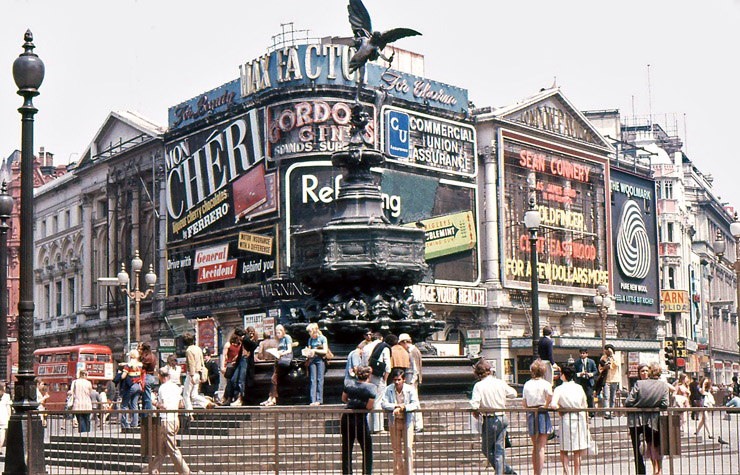 |
|
“The One and Only…
James Bond is Back!”
Diamonds Are Forever opened at the ODEON Leicester Square on Thursday
December 30, 1971, and was the only James Bond film not to have a Premiere
in London. The film was first released in Munich, West Germany on December
14, 1971, and in the United States four days later. Sean Connery had
attended the London press screening at the ODEON Leicester Square on the
morning of December 29th bringing Roger Moore as his guest, fuelling
speculation that he would be cast as the next James Bond. In the weeks
leading up to the London opening, the Capital's iconic red double-decker buses displayed
double-crown posters on their front and rear panels alerting cinemagoers
to the release date of Diamonds Are Forever. These double-crown
posters usually featured a simplified version of the main artwork and
very little text so the title would stand out at a distance. |
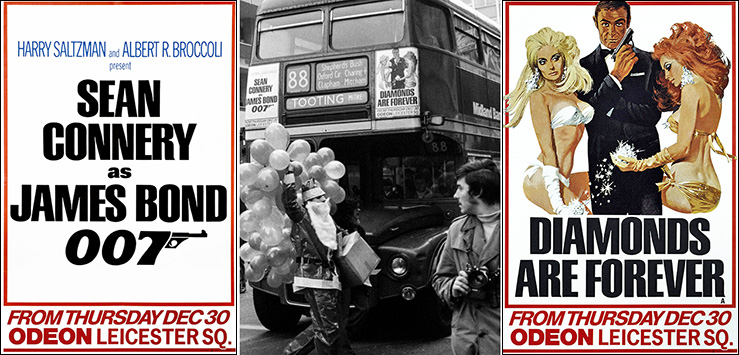 |
|
Sean Connery later
attended the Gala Scottish Premiere that was held at the ODEON Theatre,
Clerk Street, Edinburgh on Friday January 14, 1972. The premiere was held
in aid of the Scottish International Education Trust, which Sean Connery
had founded in 1971 using the $1.25-million fee he received for returning as
James Bond in Diamonds Are Forever. As part of its West End
engagement Diamonds Are Forever also played for four weeks at the
ODEON Kensington from Thursday February 3, 1972; and also three
weeks at the New Victoria from Monday February 7th. |
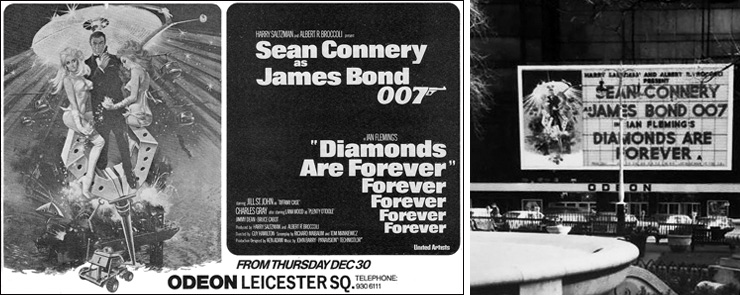 |
|
Sean Connery's comeback
as James Bond had beceom a huge hit before it even opened in the UK. The
film first played in Germany before opening at US cinemas on December 17,
1971.
Diamonds Are Forever set a film industry record by earning
$15.6-million (then around £6.5-million) in its first 12 days of worldwide
release. |
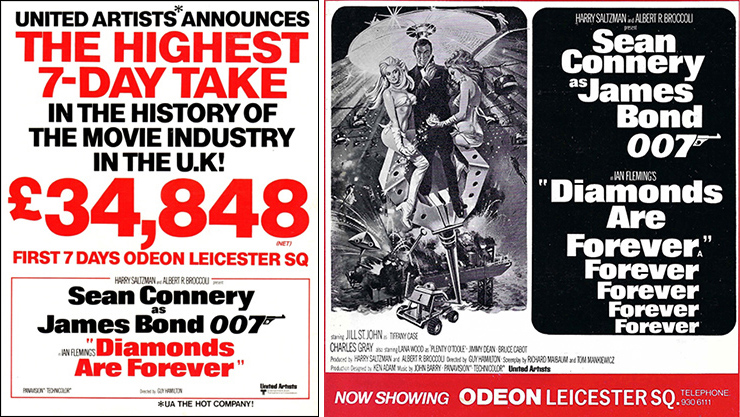 |
|
Diamonds Are Forever
once again broke box-office records at the ODEON Leicester Square,
taking £34,848 in its first week (the highest 7-day take in the
history of the UK movie industry at that point). The final performance on
Thursday January 13, 1972, however got off to a slow start, reported the
Daily Mail
the following day. Advertised to start at 8.15pm after the short cartoon
support, Diamonds Are Forever eventually appeared at 9.00pm after
half-an-hour of vacant screen time. The audience expressed their
disapproval with a spontaneous display of slow-handclapping, a phenomenon
usually reserved for more boring evenings at the theatre, rather than a
West End cinema!
|
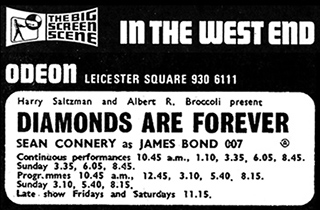 |
With five
performances each weekday and an additional late show on Fridays and
Saturdays,
Diamonds Are Forever frequently played to full houses during its
13-week engagement. With UK cinema attendance at an all-time low in
1971, Sean Connery's comeback as 007 proved incredibly popular despite
the fact his return was a one-off. Even the morning screenings grew in
popularity, and on one day ODEON employees counted a queue of almost
700 eager cinemagoers waiting in the freezing cold an hour before the
doors opened for the 10.45am performance.
Whilst Diamonds Are Forever was showing at the ODEON Kensington
in February 1972, the
Moon Buggy made the first of many appearances to promote the release
of the film. The ODEON Kensington screened the film for Rank
cinema managers who were then photographed with the Moon Buggy. These
photographs later appeared in various local newspapers once
Diamonds Are Forever went on general release. Pictured (left) in
the Moon Buggy – accompanied by two ‘James Bond Girls’ – is Ray
Potter; motoring correspondent, ex-motor racer, and proprietor of the
Hackney Gazette.
The Moon Buggy was then showcased at other
events in England throughout 1972 until it became redundant as a
marketing tool and eventually unceremoniously dumped in a farmer's
field in Hextable, Kent – where it fell into a state of major
disrepair whilst exposed to the elements for the next decade. The Moon
Buggy was then rediscovered in 1983, but after 1985 its whereabouts
again became a mystery. In 1992
the Moon Buggy was
rediscovered by 007 MAGAZINE Editor & Publisher Graham Rye, who
purchased the unique vehicle and directed its restoration. |
|
|
Although it had
played in several key cities in January/February, Diamonds Are Forever
then went on general release across the UK from Sunday March 26, 1972, when the majority of its audience would see it. The trade announcement
[pictured below] in Cinema TV Today (formerly Kine Weekly,
soon to become
Screen International) showed that Diamonds
Are Forever would open at the London Pavilion on February 24, 1972,
but this was not actually the case. In its place distributor United Artists
initiated a season of Sean Connery's five previous James Bond films which
started on Thursday February 17, 1972, and played for six weeks until Sunday March 26, 1972. |
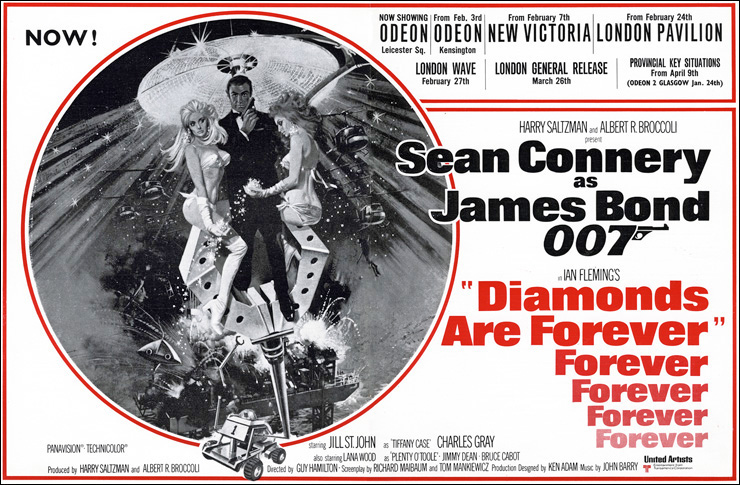 |
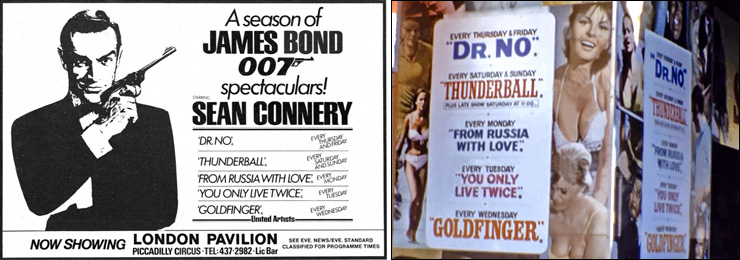 |
|
Dr. No opened
the season and played each week on Thursday and Friday;
Thunderball screened on Saturday and Sunday, From Russia With Love
on Monday; You Only Live Twice on Tuesday, with Goldfinger
shown
on Wednesday. Each film had three performances a day with an additional
late-night screening of Thunderball on Saturdays at 11.00pm. |
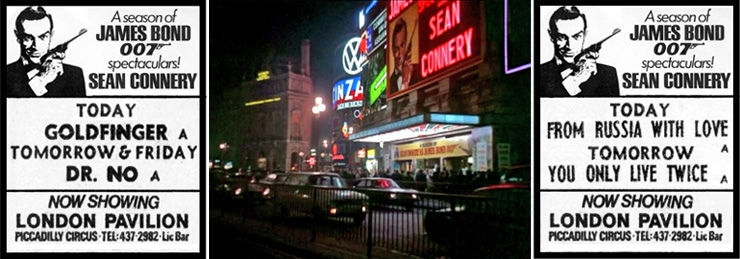 |
|
A very small number
of posters were produced for display on the London Underground to
advertise the six-week season of James Bond films that played
exclusively at the London Pavilion. One of these posters can be
briefly seen in the 1972 British cult horror film Death Line (known
in the USA as Raw Meat), which was filmed whilst the season was
screening. The poster can be seen in the platform exit in Russell
Square Underground station, and has been defaced - adding large ears
and a pair of spectacles to Sean Connery's face! |
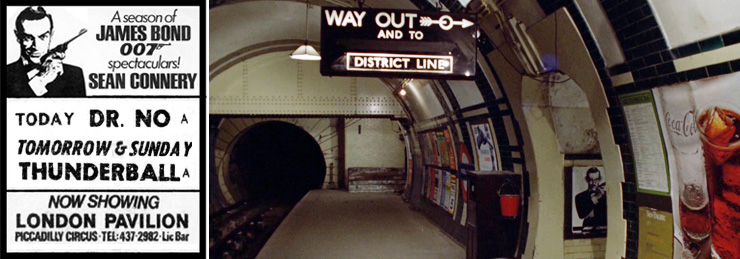 |
|
ABOVE: (right)
Death Line (1972) was a surprisingly gory (for its
time) British modern day horror film written & directed by
American Gary Sherman, and released in a cut version in the UK
in October 1972. The US release a year later was edited even
further and re-titled Raw Meat. The film stars Donald
Pleasence [Blofeld in You Only Live Twice (1967)], who
shares one brief scene with Christopher Lee [Scaramanga in
The Man With The Golden Gun (1974)] in a cameo role as
Stratton-Villiers, MI5. Also appearing is James Cossins who
played Colthorpe in The Man With The Golden Gun (1974).
Death Line was not released in its uncut form until
2006. |
|
|
|
In a similar release
pattern to the two previous James Bond films, Diamonds Are Forever
was pre-booked into selected ODEON (and Regal, Granada and Astoria)
theatres in Greater London for a two or three-week engagement from
Sunday February 27, 1972 - with a dozen of these cinemas having a
special late-night show on Saturday 26th. Advertised as a ‘Special
Presentation’ this gave more Londoners the opportunity to see the new
James Bond film whilst it was still playing in the West End, and
before it went on general release on Sunday March 26, 1972. This
release pattern was similar to the ‘PREMIERE SHOWCASE’ model adopted
for Goldfinger (1964) and Thunderball (1965), as many of
the same larger cinemas were chosen for the three-week engagement.
Even though Diamonds Are Forever
was hugely popular on its original London release, cinema attendance
in general was still in decline, falling by 40% in the past decade to
an all-time low of 176-million admissions in 1971. As the decline
continued, many venues were converted into Bingo Halls, or closed altogether. This was the case for the 2,500-seat
ODEON Chelsea located on the King's Road in South West London. Opened
in 1934 as the Gaumont Palace, the final film screened was Diamonds
Are Forever and the cinema closed after the last
performance on Saturday March 11, 1972. A new much smaller 739-seat
ODEON cinema was created from the old balcony area in 1973, and the
venue re-opened on September 9th with Live And Let Die as
the first film screened. The revival was short-lived however, and the
cinema closed again on November 21, 1981.
After finishing its
13-week premiere engagement at the ODEON Leicester Square, Diamonds Are Forever
went on general release and
transferred to the London Pavilion from Monday, March 27, 1972;
playing for further
9-weeks until Wednesday May 31st, but continued to screen across
the country until late October. |
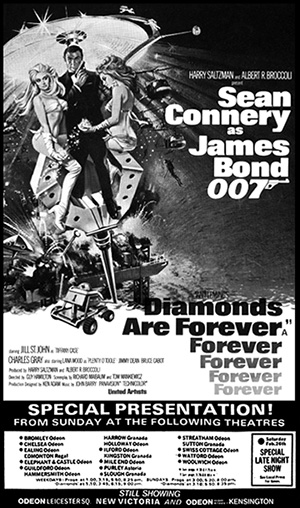 |
|
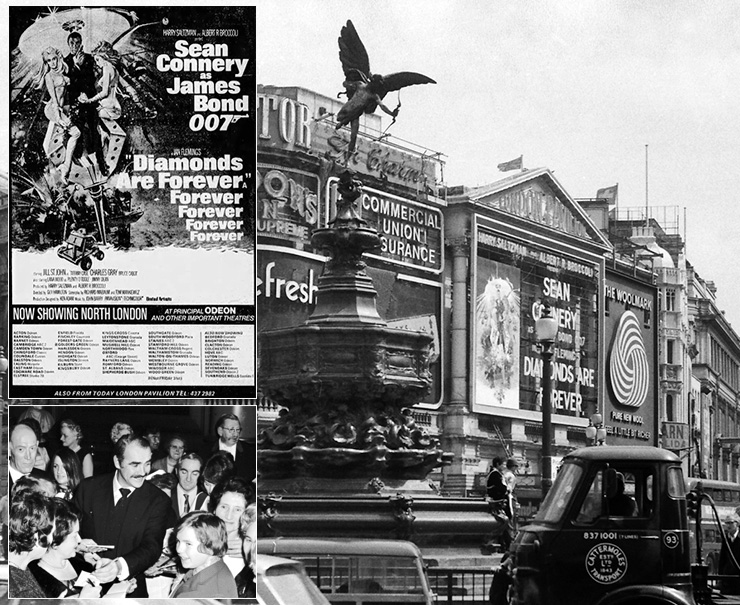 |
|
ABOVE & BELOW: Diamonds
Are Forever played at the London Pavilion for nine weeks
from Monday March 27, 1972. The large exterior marquee featured
the same display artwork used at the ODEON Leicester Square.
[inset above] Sean Connery at the Gala Scottish Premiere of
Diamonds Are Forever held at the ODEON Theatre, Clerk Street,
Edinburgh on Friday January 14, 1972. |
|
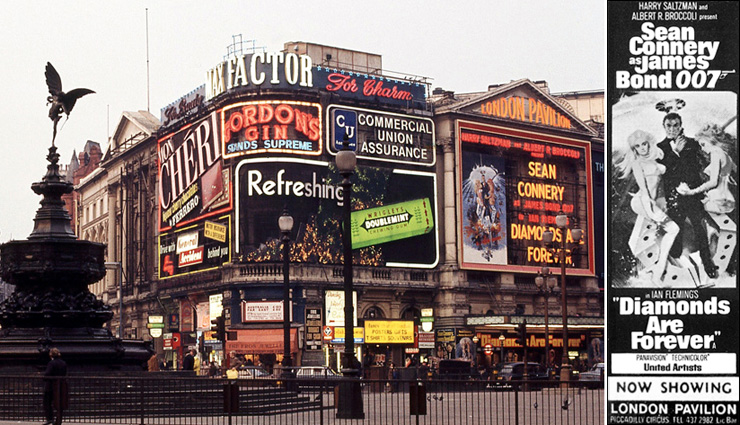 |
|
|
“Big, Brilliant Bondshell!”
Sean Connery's
James Bond films could then be seen in various combinations across the UK
before the release of Roger Moore's debut as 007 in Live And Let Die.
Whilst Diamonds Are Forever was still on general release, United
Artists also paired Dr. No on a double-bill with Thunderball
which played in North London cinemas from Sunday May 7, 1972, and South
London a week later. The new pairing was accompanied by an eye-catching
quad-crown poster utilising the Renato Fratini illustration from the
original UK From Russia With Love advertising campaign, and also
seen on the newspaper advertisements for the 1972 London Pavilion season. With Diamonds Are Forever
now playing at the
London Pavilion the Dr. No/Thunderball double-bill played
for seven days from Thursday May 4, 1972, at the New Victoria. The same day
Diamonds Are Forever opened at the Berkeley, Tottenham Court Road
where it played for one week; and also at the Gala Royal, Marble Arch,
where it went on to play for an unbroken 21-weeks
until Wednesday September 27, 1972. Diamonds Are Forever had
therefore screened continuously in London's West End for a staggering nine
months! |
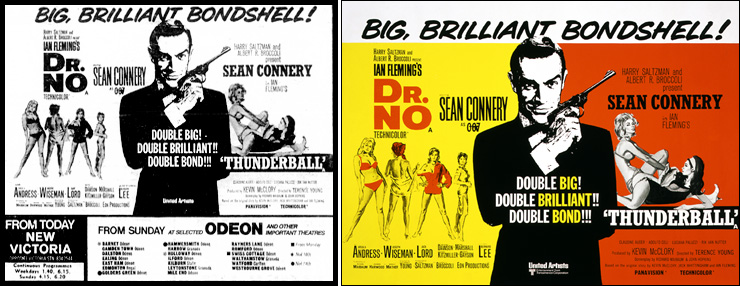 |
|
From Russia With Love was
then paired with
Diamonds Are Forever at the London Pavilion for three weeks from
Thursday May 31, 1973, and finished this exclusive West End engagement just two weeks before the opening of
Live And Let Die at the ODEON Leicester Square. |
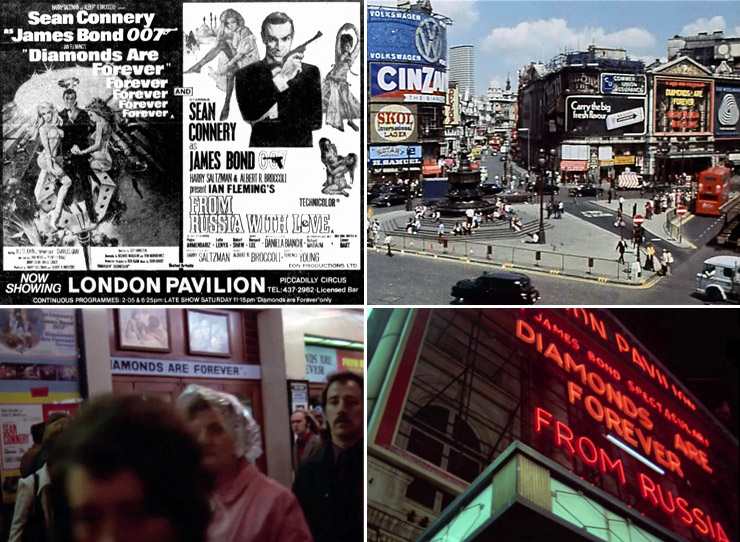 |
|
The double-bill later had
a general release across the UK from November 1973
after Live And Let Die had finished its West End release, this time accompanied by a new quad-crown double-bill poster. This was not created
for the London Pavilion engagement which utilised the 1971 Diamonds Are
Forever quad-crown poster, and the 1965 From Russia With Love
re-issue version. The National Screen Service produced
quad-crown posters for many of
these revivals, and also made composite advert blocks available to newspapers for
other combinations of films that did not have a corresponding poster. |
|
 |
 |
|












